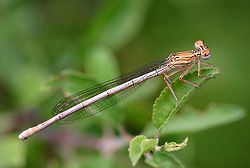| Featherlegs | |
|---|---|
 | |
| Platycnemis pennipes | |
| Scientific classification | |
| Kingdom: | Animalia |
| Phylum: | Arthropoda |
| Class: | Insecta |
| Order: | Odonata |
| Suborder: | Zygoptera |
| Family: | Platycnemididae |
| Genus: | Platycnemis Burmeister, 1839 |
Platycnemis is a genus of damselfly in the family Platycnemididae.
The name comes from the Greek words platos (πλατυς) 'flat' and cnemis (κνημη) 'shin'. [1] They are commonly known as featherlegs.
The genus contains the following species: [2]
- Platycnemis acutipennis Selys, 1841 – Orange Featherleg [3]
- Platycnemis agrioides Ris, 1915
- Platycnemis alatipes (McLachlan, 1872)
- Platycnemis aurantipes Lieftinck, 1965
- Platycnemis bilineata Bartenev, 1919
- Platycnemis congolensis Martin, 1912
- Platycnemis dealbata Selys in Selys & Hagen, 1850 – Ivory featherleg [4]
- Platycnemis echigoana Asahina, 1955
- Platycnemis foliacea Selys, 1886
- Platycnemis foliosa Navás, 1932
- Platycnemis guttifera Fraser, 1950
- Platycnemis hova Martin, 1908
- Platycnemis kervillei (Martin, 1909) – Powdered featherleg, [4] Kerville's featherleg [5]
- Platycnemis latipes Rambur, 1842 – White featherleg [3] [4]
- Platycnemis longiventris Schmidt, 1951
- Platycnemis malgassica Schmidt, 1951
- Platycnemis melanus Aguesse, 1968
- Platycnemis nitidula (Brullé, 1832)
- Platycnemis nyansana Förster, 1916
- Platycnemis pennipes (Pallas, 1771) – Blue featherleg, [3] White-legged Damselfly [6]
- Platycnemis phasmovolans Hämäläinen, 2003
- Platycnemis phyllopoda Djakonov, 1926
- Platycnemis pierrati (Navás, 1935)
- Platycnemis protostictoides Fraser, 1953
- Platycnemis pseudalatipes Schmidt, 1951
- Platycnemis rufipes (Selys, 1886)
- Platycnemis sanguinipes Schmidt, 1951
- Platycnemis sikassoensis (Martin, 1912)
- Platycnemis subdilatata Selys, 1849 – Barbary featherleg [4]
